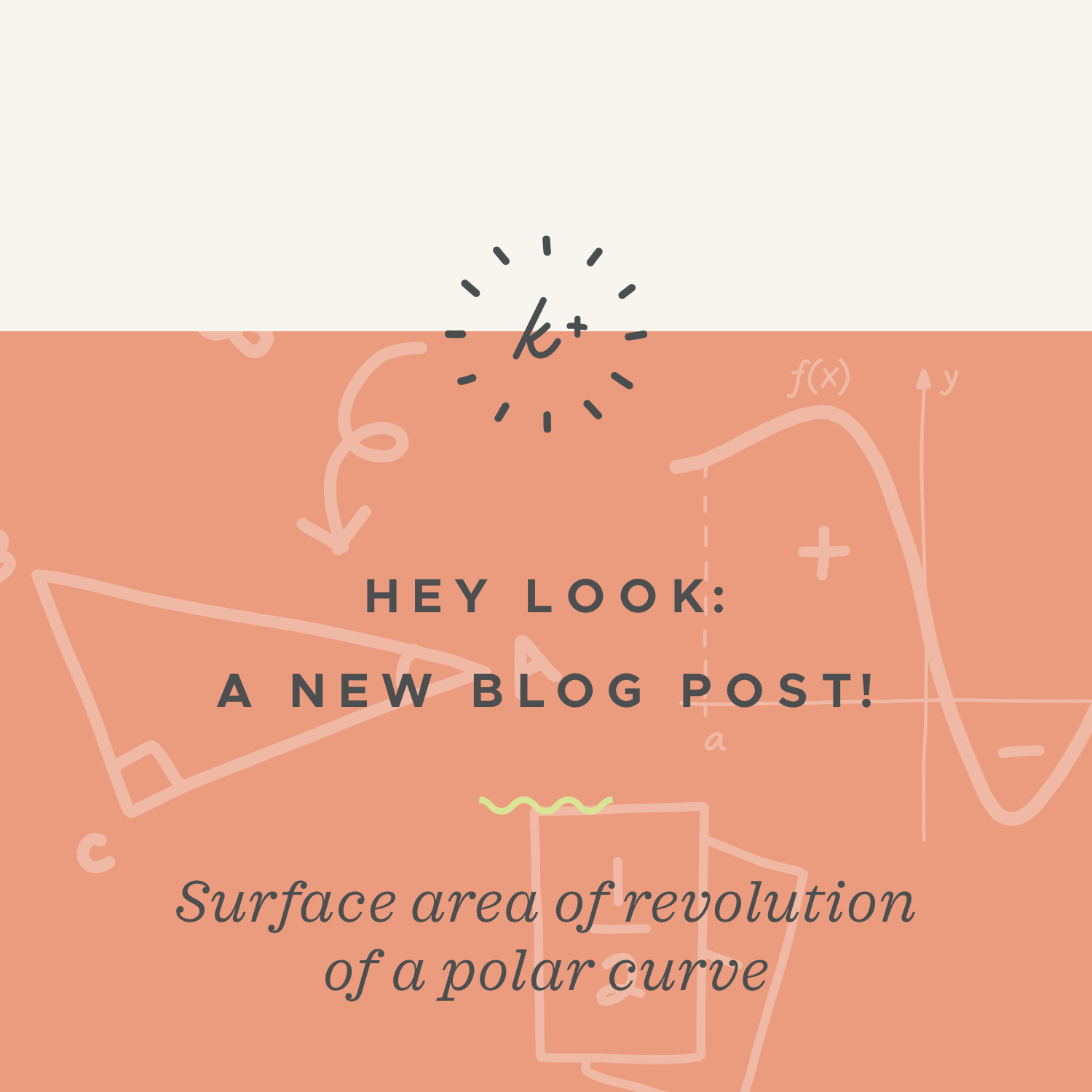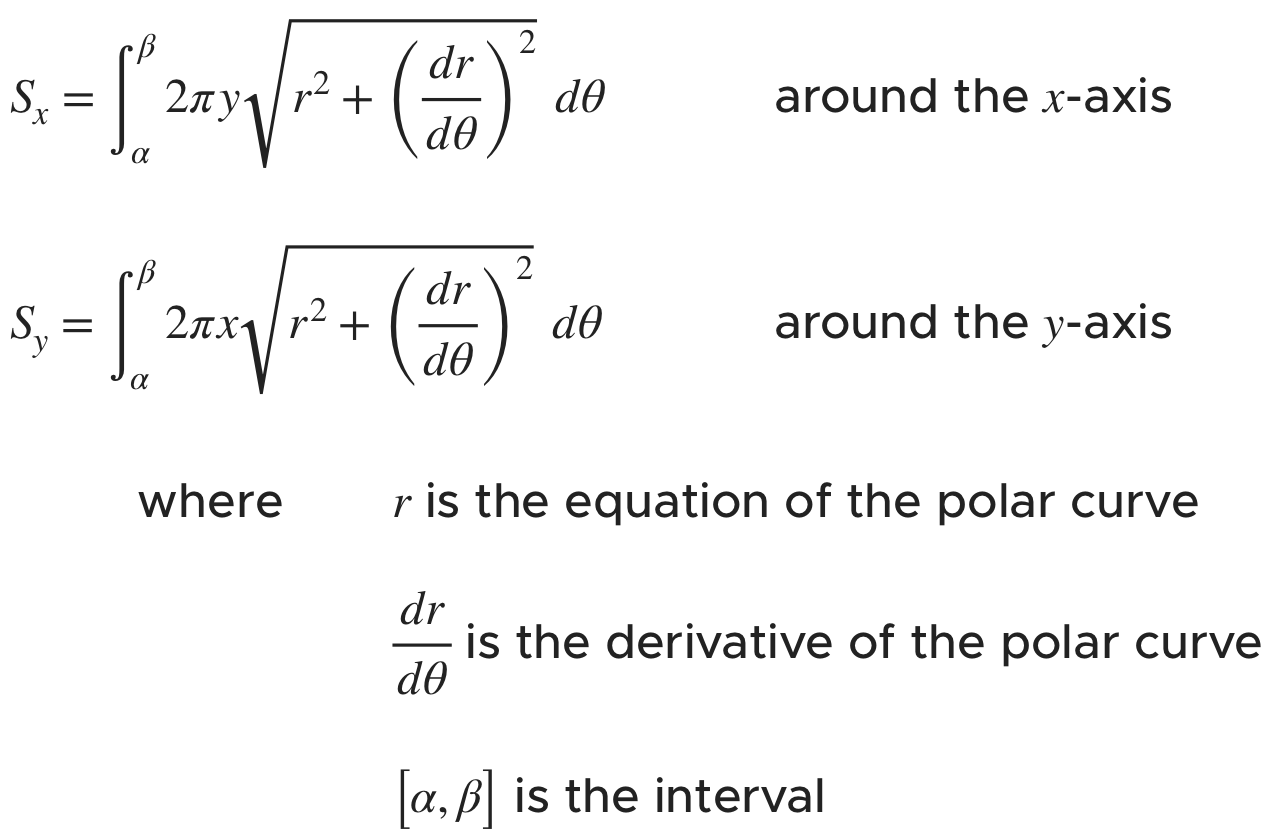How to find the surface area of revolution of a polar curve
The formulas we’ll use to find the surface area of revolution of a polar curve
We can find the surface area of the object created when we rotate a polar curve around either the ???x???-axis or the ???y???-axis using the formulas
Hi! I'm krista.
I create online courses to help you rock your math class. Read more.
We can solve for ???x??? and ???y??? as needed using the conversion formulas
???x=r\cos{\theta}???
???y=r\sin{\theta}???
How to find the surface area of revolution when we revolve a polar curve around a specific axis, over a specific interval
Take the course
Want to learn more about Calculus 2? I have a step-by-step course for that. :)
Surface area of revolution of a polar curve when we revolve around the y-axis
Example
Find the surface area of revolution of the polar curve over the interval ???0\le\theta\le\pi???, rotated around the ???y???-axis.
???r=5\cos{\theta}???
Before we can plug into the formula, we need to find ???x??? and ???dr/d\theta???.
Since ???x=r\cos{\theta}???, we get
???x=5\cos{\theta}\cos{\theta}???
???x=5\cos^2{\theta}???
To find ???dr/d\theta???, we’ll take the derivative of the given polar equation.
???r=5\cos{\theta}???
???\frac{dr}{d\theta}=-5\sin{\theta}???
We’ll plug everything into the formula for the surface area of revolution about the ???y???-axis.
???S_y=\int^{\beta}_{\alpha}2\pi{x}\sqrt{r^2+\left(\frac{dr}{d\theta}\right)^2}\ d\theta???
???S_y=\int^{\pi}_02\pi\left(5\cos^2{\theta}\right)\sqrt{\left(5\cos{\theta}\right)^2+\left(-5\sin{\theta}\right)^2}\ d\theta???
???S_y=10\pi\int^{\pi}_0\cos^2{\theta}\sqrt{25\cos^2{\theta}+25\sin^2{\theta}}\ d\theta???
???S_y=10\pi\int^{\pi}_0\cos^2{\theta}\sqrt{25\left(\cos^2{\theta}+\sin^2{\theta}\right)}\ d\theta???
We can find the surface area of the object created when we rotate a polar curve around either the x-axis or the y-axis
Since ???\cos^2{\theta}+\sin^2{\theta}=1???,
???S_y=50\pi\int^{\pi}_0\cos^2{\theta}\sqrt{1}\ d\theta???
???S_y=50\pi\int^{\pi}_0\cos^2{\theta}\ d\theta???
Since ???\cos^2{\theta}=\frac12\left[1+\cos{(2\theta)}\right]???,
???S_y=50\pi\int^{\pi}_0\frac12\left[1+\cos{(2\theta)}\right]\ d\theta???
???S_y=50\pi\int^{\pi}_0\frac12+\frac12\cos{(2\theta)}\ d\theta???
???S_y=25\pi\int^{\pi}_01+\cos{(2\theta)}\ d\theta???
???S_y=25\pi\left[\theta+\frac{1}{2}\sin{(2\theta)}\right]\bigg|^{\pi}_0???
???S_y=25\pi\theta+\frac{25\pi}{2}\sin{(2\theta)}\bigg|^{\pi}_0???
???S_y=25\pi(\pi)+\frac{25\pi}{2}\sin{(2\pi)}-\left[25\pi(0)+\frac{25\pi}{2}\sin{(2(0))}\right]???
???S_y=25\pi^2+\frac{25\pi}{2}(0)-25\pi(0)-\frac{25\pi}{2}(0)???
???S_y=25\pi^2???







